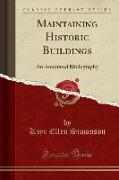- Start
- Maintaining Historic Buildings
Maintaining Historic Buildings
Angebote / Angebote:
Excerpt from Maintaining Historic Buildings: An Annotated BibliographyIn the preservation of historic buildings, the most critical area, and the most overlooked, is that of maintenance. All too often, it is based on short term economic decisions rather than long-term preservation goals, and deferred until the building deteriorates to such a point that a costly repair project must be undertaken to recover its historic appearance. The rewards of maintenance may seem too subtle to notice at first, in fact, small, repeated work tasks may even appear to be unproductive because there is no immediately visible evidence of their benefit. Often, it is only when major repairs or restoration are required that the true value of regular, scheduled maintenance is seen.The aim of preservation is to manage the inevitable deterioration of a building. Maintenance is the almost constant application of preservation treatments to reduce wear and deterioration and prolong the life of a building. A good maintenance plan, based on the preservation goals for the building and its use, is the key to successful preservation. Maintenance without a plan can be just as destructive as no maintenance at all, with each patch and repair destroying a bit more of the original fabric until integrity is lost. Or it may have the opposite effect, improving on the original design, which may have been built with defects, or eliminating all signs of normal wear and weathering. The result is a well maintained building looking nothing like it would have historically.The components of a good maintenance plan are: the inspection system, work schedules, building records, report systems, and reference support materials. An effective plan should also include a means of evaluating maintenance activities to find strengths and weaknesses (and adjusting the plan as needed) and a system of cost accounting, as well as a training program for any personnel involved in the maintenance of the building.The building inspection is the basis of a good maintenance plan. Full inspections should be performed annually and are used to identify maintenance tasks and pinpoint areas of concern that require further monitoring. Other inspections should be done on a regular basis. Still other inspections should be done on an as-needed basis, for example, the roof should be examined during a heavy rain and after severe storms, collections should be checked for insects and other damage monthly, and a casual inspection should be included in every housekeeping routine.About the PublisherForgotten Books publishes hundreds of thousands of rare and classic books. Find more at www.forgottenbooks.comThis book is a reproduction of an important historical work. Forgotten Books uses state-of-the-art technology to digitally reconstruct the work, preserving the original format whilst repairing imperfections present in the aged copy. In rare cases, an imperfection in the original, such as a blemish or missing page, may be replicated in our edition. We do, however, repair the vast majority of imperfections successfully, any imperfections that remain are intentionally left to preserve the state of such historical works.
Folgt in ca. 5 Arbeitstagen
